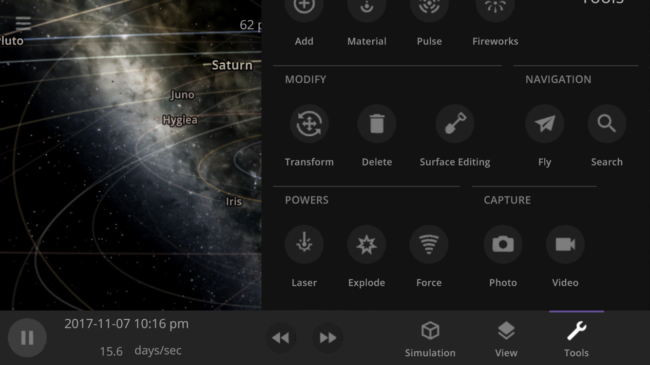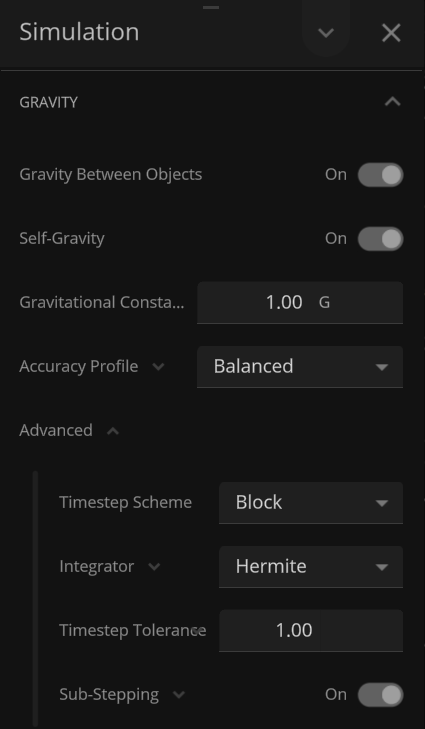Archive for August, 2023

Universe Sandbox for Mobile | Development Challenges | Update 2
Aug 23rd
Bringing the complete Universe Sandbox experience to mobile is an exciting and challenging project, and while development was stalled while hiring a new user interface engineer, we are back on track! While we still don’t have a release date for Universe Sandbox on mobile, we want to share our recent progress and current obstacles.
For an overview of our plans for Universe Sandbox on mobile devices, you can read our first Mobile DevLog.

Pocket-Sized Complexities
We’ve been thinking about Universe Sandbox mobile for a long time and have been developing our panels and buttons to be easy to view and use on small screens for years. In fact, Universe Sandbox mobile is built from the exact same code as the version you already know and love, so it will have the same features and user interface as the desktop experience.
This shared codebase means you can enjoy any new features and improvements we add to Universe Sandbox on any device, whether you’re on a desktop, laptop, VR headset, phone, or tablet.
While these are seemingly simple goals, they create complex design challenges:
- How to automatically arrange panels and adjust your view so you can focus on controlling the simulation, not having to manage the user interface
- Switching between multiple panels, like an object’s properties, data views, and guide instructions, on small screens in landscape and portrait modes
- Overhauling our simulation tools (like explode, laser, and planetscaping), to adapt to all screen sizes

Under New (Layout) Management
While most other simulators and games have a different user interface for their mobile and desktop versions, we want ours to use the exact same interface for all platforms. We think we’re among the first to do this, but if you know of another or have done this with your game, please let us know! You can see what Universe Sandbox mobile might look like right now (including why we haven’t released it yet) by resizing the Universe Sandbox window on your computer to the size of your phone (since our user interface dynamically responds to your window size).
While we are still making performance improvements so Universe Sandbox can run smoothly on phones, our primary obstacle in mobile development is ensuring our interface is usable on a small touch screen like a phone. We’ve started tackling it by designing a system to intelligently hide and reveal panels as they open and close, which we’re calling our Dynamic Layout System.
While creating this system will take time, it should allow future improvements and new features to work in Universe Sandbox without any extra development, regardless of whether you’re playing on mobile or desktop. That means we’ll have more time to work on new features instead of spending time implementing the same feature in two different ways.

Current Progress
We’ve been researching the best way to create this dynamic panel management system and have made significant progress implementing it within Universe Sandbox.
There’s still other work to be done, and we do not have a release date or official price for mobile, but we’re still planning on it being a one-time paid app with no ads or in-app purchases.
We have yet to finalize the minimum device requirements for the mobile version, but it will likely require a modern device with decent specs. We will share more about hardware requirements as soon as we finalize them.
Taking a feature-rich, user-interface-heavy desktop game and porting it to mobile presents many challenges, but we are excited to tackle them and create an experience unlike any other at your fingertips.
To receive updates about mobile, like this one, sign up for our mailing list:
http://universesandbox.com/mobile/
Join our community discussions on our Steam Forum and our official Discord community.

Gravity Simulation Upgrade | Update 33
Aug 16th

If Update 33 does not download automatically, follow these update instructions. If you don’t own Universe Sandbox, you can buy it via our website.
Gravity Simulation
We’ve completely overhauled our gravity simulation to increase accuracy, stability, and overall performance. Run simulations at higher speeds than ever before while maintaining gravitational accuracy.

Many simulations can now be run at noticeably higher simulation speeds. Try increasing the simulation speed of the Solar System simulation or your own custom simulation.

Before

After
The Hubble Space Telescope used to crash into or fly away from Earth at simulation speeds greater than a couple days per second. Now it maintains a stable orbit at much higher simulation speeds.


Choreography simulations, where moons are distributed evenly over a pre-computed path creating a unique design, are much more stable and create the desired patterns, like this fish, before becoming gravitationally unstable and falling apart, as expected.


We’ve also added more controls so you can fine-tune the balance between maximum simulation speed and gravitational accuracy. Learn more in our updated guide
Guides > Tutorials > Advanced Simulation Speed Controls

More Highlights
Small objects colliding with gas giants now create more realistic impacts with smaller, gradually growing impact areas


Object selection has been completely rewritten. It’s now much easier to select objects in crowded simulations with lots of dust clouds and fragments.


Check out the full list of What’s New in Update 33
Please report any issues on our Steam forum, on Discord, or in-game via Home > Send Feedback.
